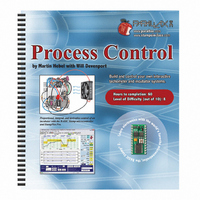122-28176 Parallax Inc, 122-28176 Datasheet - Page 16

122-28176
Manufacturer Part Number
122-28176
Description
GUIDE STUDENT PROCESS CONTROL
Manufacturer
Parallax Inc
Specifications of 122-28176
Accessory Type
Manual
Product
Microcontroller Accessories
Lead Free Status / RoHS Status
Contains lead / RoHS non-compliant
For Use With/related Products
Propeller Education (PE) Kit
Lead Free Status / RoHS Status
Lead free / RoHS Compliant, Contains lead / RoHS non-compliant
- Current page: 16 of 330
- Download datasheet (11Mb)
As humans, we typically work with questions resulting in yes/no. In flowcharting, it is
better to use statements that result in true/false due to the logical nature of programming
where conditions are checked to be true or false. Take the following example for the
shower process:
In programming, a typical condition may be:
In this example, when the condition is checked, the equality will either be true or false.
Using true/false statements makes the transition from the flowchart to the programming
language easier.
Challenge 1-1: Modify the Flowchart for True/False
ACTIVITY #2: SEQUENTIAL FLOW AND CODE
"Sequential flow" means moving from one operation to the next with no branches being
made. In this activity a simple circuit will be used to illustrate principles of sequential
flow and how the PBASIC language is used in programming the BASIC Stamp.
Parts Required
(3) Resistors – 220 Ω
(1) Resistor – 1 kΩ
(1) Photoresistor
(1) Pushbutton – Normally Open
(1) LED – Red
(1) Piezospeaker
(1) Capacitor – 0.1 µF
•
•
√
Is the water too hot? YES – Turn down the hot.
The water is too hot. TRUE – Turn down the hot.
IF (Water_Temp > 95) THEN …
Modify the flowchart in Figure 1-2 to use true/false statements instead of yes/no
questions.
Related parts for 122-28176
Image
Part Number
Description
Manufacturer
Datasheet
Request
R

Part Number:
Description:
MANUAL FOR SUMOBOT
Manufacturer:
Parallax Inc
Datasheet:

Part Number:
Description:
GUIDE STUDENT SMART SENSORS
Manufacturer:
Parallax Inc
Datasheet:

Part Number:
Description:
MANUAL PROPELLER
Manufacturer:
Parallax Inc
Datasheet:

Part Number:
Description:
LEAD WIRES FLYING CABLE III/IV
Manufacturer:
Xilinx Inc
Datasheet:

Part Number:
Description:
BOARD ADAPTER AND FLY LEADS
Manufacturer:
Xilinx Inc
Datasheet:

Part Number:
Description:
PLATFORM CABLE USB II
Manufacturer:
Xilinx Inc
Datasheet:

Part Number:
Description:
KIT STARTER COOLRUNNER-II BUNDLE
Manufacturer:
Xilinx Inc
Datasheet:

Part Number:
Description:
Microcontroller Modules & Accessories DISCONTINUED BY PARALLAX
Manufacturer:
Parallax Inc

Part Number:
Description:
Microcontroller Modules & Accessories DISCONTINUED BY PARALLAX
Manufacturer:
Parallax Inc

Part Number:
Description:
BOOK UNDERSTANDING SIGNALS
Manufacturer:
Parallax Inc
Datasheet:

Part Number:
Description:
BOARD EXPERIMENT+LCD NX-1000
Manufacturer:
Parallax Inc
Datasheet:

Part Number:
Description:
IC MCU 2K FLASH 50MHZ SO-18
Manufacturer:
Parallax Inc
Datasheet:












